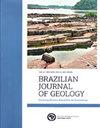巴西东北部Paramirim断裂带Rio dos remsamdios群稀有蓝色含石英变质火山岩的多方法表征
IF 0.9
4区 地球科学
Q3 GEOSCIENCES, MULTIDISCIPLINARY
引用次数: 0
摘要
本文章由计算机程序翻译,如有差异,请以英文原文为准。
Multi-method characterization of rare blue quartz-bearing metavolcanic rocks of the Rio dos Remédios Group, Paramirim Aulacogen, NE Brazil
The Rio dos Remédios Group comprises a supracrustal sequence that occupies the base of the Espinhaço Supergroup, São Francisco Craton, Brazil. Its basal formation, Novo Horizonte, crops out in the Paramirim region mainly as metavolcanic rocks that represent one of the fewer occurrences of blue quartz phenocrysts in South America. Their mineralogy consists of quartz and K-feldspar phenocrysts, whereas biotite, muscovite, fluorite, allanite, chlorite, sericite, zircon, and opaque phases occur immersed in a quartz-feldspar-rich groundmass. Such heterogeneous composition is also supported by x-ray diffraction and chemical data. Electron probe microanalysis in some samples revealed the presence of two distinct groups of biotite (magmatic and neoformed), in addition to the presence of iron-rich white mica and almost pure orthoclase feldspar. Our data suggest that the studied metavolcanic rocks have maintained their magmatic characteristics, which were progressively overprinted by hydrothermal fluids and ductile-to-brittle deformation. The magmatic mineralogy is akin to strongly peraluminous and alkaline magmas, common in anorogenic settings – a fertile site for the origin of blue quartz-bearing rocks worldwide.
求助全文
通过发布文献求助,成功后即可免费获取论文全文。
去求助
来源期刊

Brazilian Journal of Geology
GEOSCIENCES, MULTIDISCIPLINARY-
CiteScore
3.20
自引率
7.10%
发文量
12
审稿时长
11 weeks
期刊介绍:
The Brazilian Journal of Geology (BJG) is a quarterly journal published by the Brazilian Geological Society with an electronic open access version that provides an in-ternacional medium for the publication of original scientific work of broad interest concerned with all aspects of the earth sciences in Brazil, South America, and Antarctica, in-cluding oceanic regions adjacent to these regions. The BJG publishes papers with a regional appeal and more than local significance in the fields of mineralogy, petrology, geochemistry, paleontology, sedimentology, stratigraphy, structural geology, tectonics, neotectonics, geophysics applied to geology, volcanology, metallogeny and mineral deposits, marine geology, glaciology, paleoclimatology, geochronology, biostratigraphy, engineering geology, hydrogeology, geological hazards and remote sensing, providing a niche for interdisciplinary work on regional geology and Earth history.
The BJG publishes articles (including review articles), rapid communications, articles with accelerated review processes, editorials, and discussions (brief, objective and concise comments on recent papers published in BJG with replies by authors).
Manuscripts must be written in English. Companion papers will not be accepted.
 求助内容:
求助内容: 应助结果提醒方式:
应助结果提醒方式:


